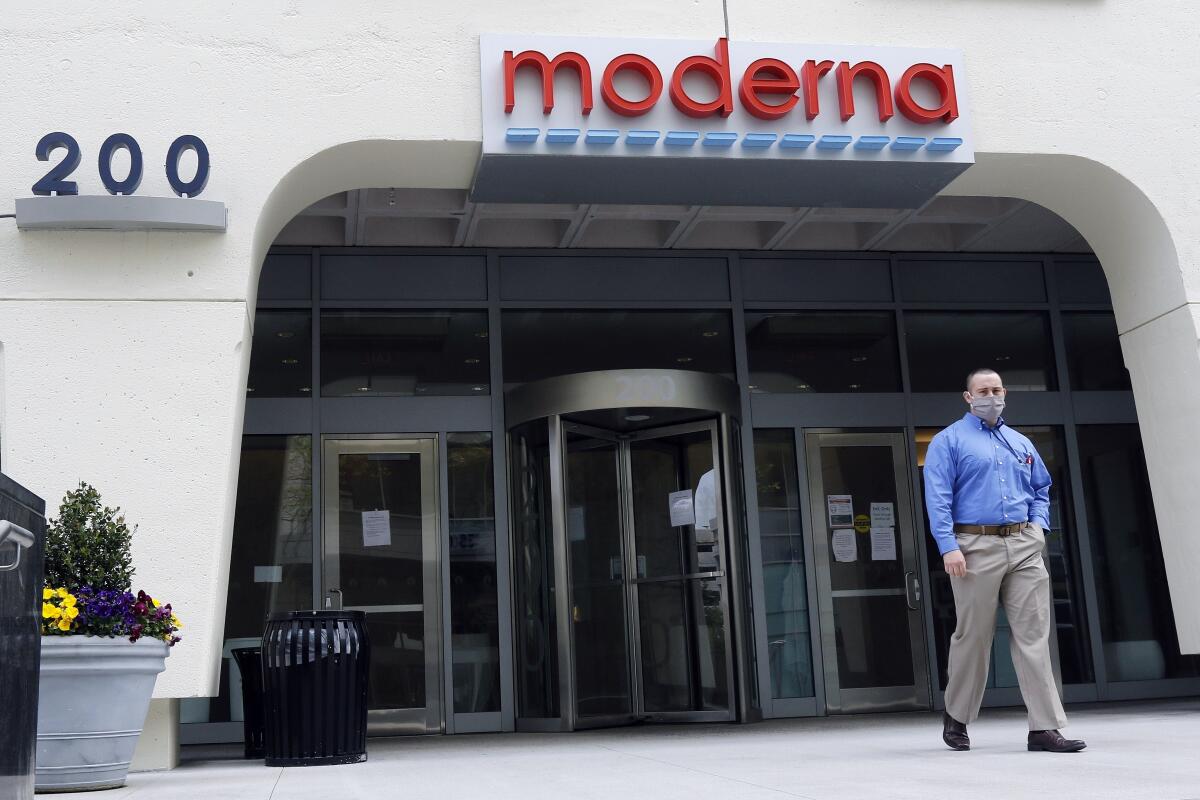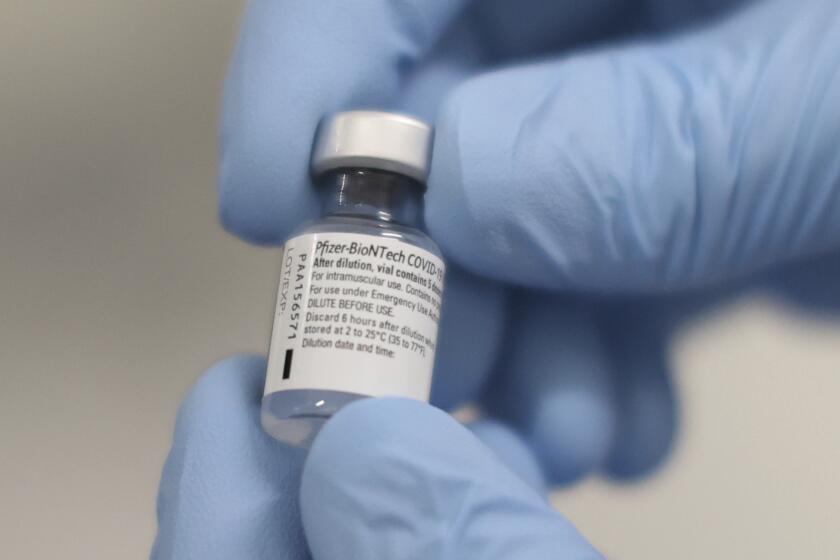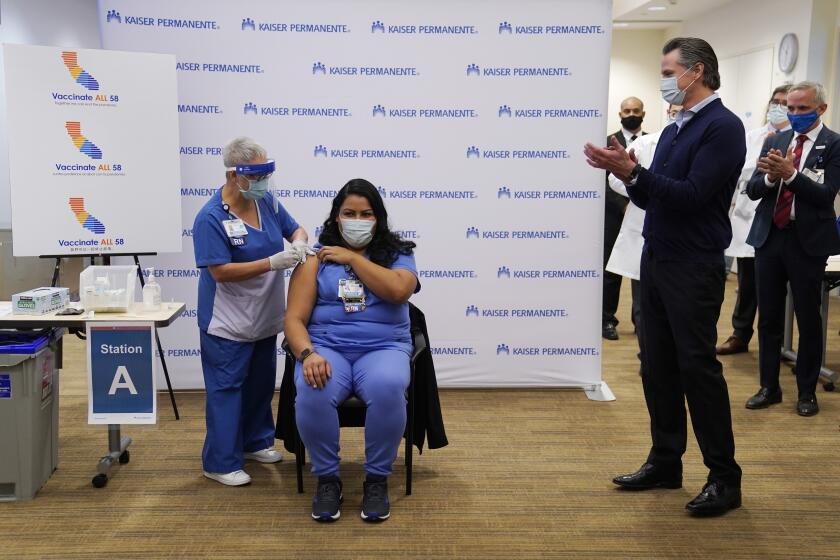Moderna vaccine set for emergency use authorization with FDA advisory panel’s endorsement

- Share via
WASHINGTON — A government advisory panel endorsed a second COVID-19 vaccine Thursday, paving the way for the shot to be added to the U.S. vaccination campaign.
The Food and Drug Administration is expected to follow the recommendation and quickly OK the vaccine from Moderna and the National Institutes of Health. The FDA advisors, in a 20-0 vote, agreed the benefits of the vaccine outweighed the risks for those 18 years old and up.
Once emergency use authorization is granted, Moderna will begin shipping millions of doses, earmarked for health workers and nursing home residents, to boost the largest vaccination effort in U.S. history.
The campaign kicked off this week with the first vaccine approved in the U.S., developed by Pfizer and BioNTech. Moderna’s shot showed similarly strong protection, providing 94% protection against COVID-19 in the company’s ongoing study of 30,000 people.
After eight hours of discussion over technical details of the company’s study and follow-up plans, nearly all panelists backed making the vaccine available to help fight the pandemic. One panel member abstained.
“The evidence that has been studied in great detail on this vaccine highly outweighs any of the issues we’ve seen,” said Dr. Hayley Gans of Stanford University Medical Center.
If the COVID-19 vaccine from Pfizer and BioNTech was good enough to get a nod from the FDA, the vaccine from Moderna and the NIH almost certainly is as well.
A second vaccine is urgently needed as coronavirus infections, hospitalizations and deaths climb to new highs ahead of the holidays. The U.S. leads the world in virus totals, with a cumulative total of more than 17 million confirmed cases and more than 310,000 reported deaths.
Moderna’s vaccine uses the same groundbreaking technology as Pfizer-BioNTech’s shot. Most traditional vaccines use dead or weakened virus, but both of the new vaccines use snippets of COVID-19’s genetic code to train the immune system to detect and fight the virus. Both require two doses; Moderna’s is four weeks apart.
The two new vaccines will hopefully help “break the back of the pandemic,” said Dr. Arnold Monto of the University of Michigan, who chaired the panel.
Thursday’s review came days after reports of apparent allergic reactions to the Pfizer-BioNTech vaccine in two Alaska health workers. One person had a severe reaction, including shortness of breath. The other had less serious side effects, including lightheadedness.
Although the two vaccines use the same technology, they’re not identical, said Dr. Tal Zaks, Moderna’s chief medical officer. In particular, some of the lipids, or fats, used to coat the vaccines are different.
“I would not necessarily assume” that any reactions would be the same, he said.
The FDA found no severe allergic reactions in Moderna’s data but flagged a slightly higher rate of less serious side effects — rash, hives, itching — among participants who got the vaccine, compared with those receiving a dummy shot.
There were also three cases of Bell’s palsy, which temporarily paralyzes facial muscles, among vaccine recipients, compared with just one among those getting a dummy shot. The FDA review said the role of the shot in the vaccine group “cannot be ruled out.”
An unanswered question is whether the vaccine also prevents people from symptomless infection — but Moderna found a hint that it may. Study participants had their noses swabbed before the second dose of either vaccine or placebo. At that one point, swabs from 14 vaccine recipients and 38 placebo recipients showed evidence of asymptomatic infection, said Moderna’s Dr. Jacqueline Miller.
Moderna is just starting to study its vaccine in children ages 12 to 17. Testing in younger children is expected to start early next year.
After the FDA acts, U.S. officials plan to move out an initial shipment of nearly 6 million Moderna doses. The vaccine needs to be stored at regular freezer temperatures, rather than the ultra-cold required for the Pfizer-BioNTech shot.
With the addition of Moderna’s vaccine, government officials project that 20 million Americans will be able to get their first shots by the end of December and 30 million more in January.
Hundreds of millions of additional shots will be needed to eventually vaccinate the general public, which isn’t expected until the spring or summer. The government’s Operation Warp Speed program has orders for 200 million doses of Moderna’s vaccine. That’s on top of 100 million doses of the Pfizer-BioNTech vaccine. Officials are negotiating to buy more doses of that vaccine.
Like the first vaccine, Moderna’s vaccine will remain experimental as the company continues a two-year study needed to answer key questions, including how long protection lasts.
COVID-19 vaccines are now being administered to healthcare workers in the U.S. What are your questions about the timeline, the safety or the science?
One of the trickiest issues panelists debated was how to keep study volunteers who received a dummy shot from dropping out to get the real shot. Their participation is key in order to have a comparison for long-term safety and effectiveness.
Moderna proposed immediately alerting all those volunteers of their status and offering them the vaccine. The company said more than 25% of its participants are health workers and some are already leaving to get the first vaccine.
Dr. Steven Goodman, an invited expert from Stanford University, suggested Moderna adopt Pfizer’s approach: gradually vaccinate people in its placebo group based on when they would have normally had access to the vaccine as priority groups are established.
“I’m just happy that anything I do can help somebody else,” Dolly Parton said upon finding out she helped fund research for Moderna’s COVID-19 vaccine.
Most panelists acknowledged it will be hard to keep volunteers from leaving the Moderna study if they have to wait to get the vaccine.
“The reality may make that too difficult to do,” said Dr. Steven Pergam of the Seattle Cancer Care Alliance.
Exactly how to treat the trial participants who got dummy shots is important beyond the ethics: Moderna noted that the only COVID-19 death in the 30,000 volunteers was in a placebo recipient, a 54-year-old man whose only risk factor was diabetes.
Knowing there could be more severe coronavirus in placebo recipients as the pandemic continues “weighs heavily on me,” Moderna’s Miller said.
The COVID-19 vaccine continues to roll out throughout Southern California.
For most people, side effects should be mild and may include flu-like symptoms for a day or two. People with severe allergies should consult a doctor.











